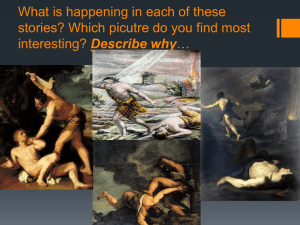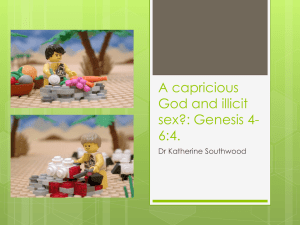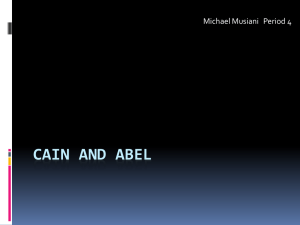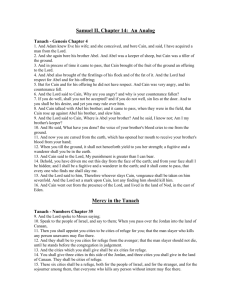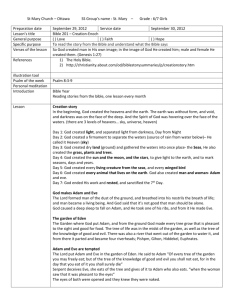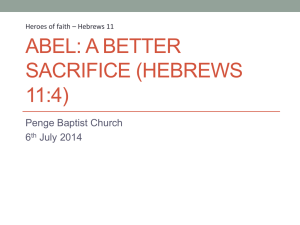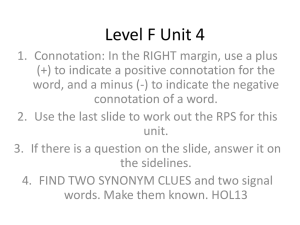CAIN AND ABEL By John Algeo - Theosophical Society in America
advertisement
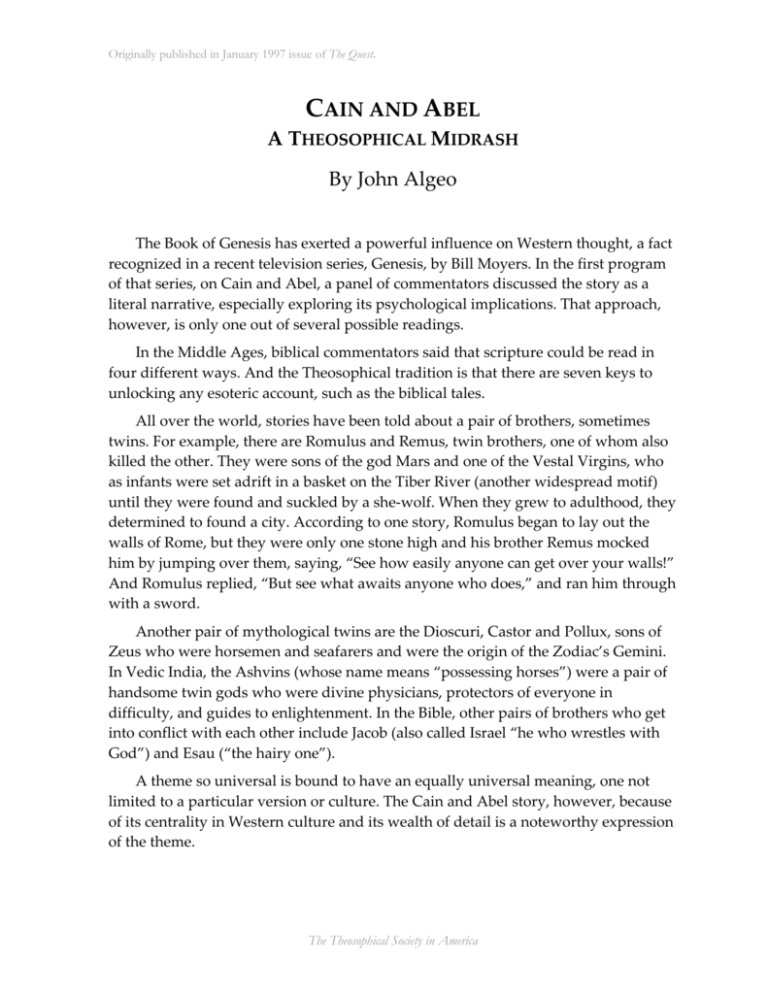
Originally published in January 1997 issue of The Quest. CAIN AND ABEL A THEOSOPHICAL MIDRASH By John Algeo The Book of Genesis has exerted a powerful influence on Western thought, a fact recognized in a recent television series, Genesis, by Bill Moyers. In the first program of that series, on Cain and Abel, a panel of commentators discussed the story as a literal narrative, especially exploring its psychological implications. That approach, however, is only one out of several possible readings. In the Middle Ages, biblical commentators said that scripture could be read in four different ways. And the Theosophical tradition is that there are seven keys to unlocking any esoteric account, such as the biblical tales. All over the world, stories have been told about a pair of brothers, sometimes twins. For example, there are Romulus and Remus, twin brothers, one of whom also killed the other. They were sons of the god Mars and one of the Vestal Virgins, who as infants were set adrift in a basket on the Tiber River (another widespread motif) until they were found and suckled by a she-wolf. When they grew to adulthood, they determined to found a city. According to one story, Romulus began to lay out the walls of Rome, but they were only one stone high and his brother Remus mocked him by jumping over them, saying, “See how easily anyone can get over your walls!” And Romulus replied, “But see what awaits anyone who does,” and ran him through with a sword. Another pair of mythological twins are the Dioscuri, Castor and Pollux, sons of Zeus who were horsemen and seafarers and were the origin of the Zodiac’s Gemini. In Vedic India, the Ashvins (whose name means “possessing horses”) were a pair of handsome twin gods who were divine physicians, protectors of everyone in difficulty, and guides to enlightenment. In the Bible, other pairs of brothers who get into conflict with each other include Jacob (also called Israel “he who wrestles with God”) and Esau (“the hairy one”). A theme so universal is bound to have an equally universal meaning, one not limited to a particular version or culture. The Cain and Abel story, however, because of its centrality in Western culture and its wealth of detail is a noteworthy expression of the theme. The Theosophical Society in America Originally published in January 1997 issue of The Quest. The story set forth in Genesis, chapter 4, is that Adam and Eve’s first son was Cain and their second, Abel. Cain grew up to be a farmer, and Abel a shepherd. Each of the brothers made an offering to God: Cain “of the fruit of the ground,” and Abel “of the firstlings of his flock and of the fat thereof.” God was happy with Abel’s offering, but not with Cain’s. When Cain got angry and sulked because his offering had been rejected, God asked him why he should behave that way, for if he did well, it would be well with him; but if he did not, it would not be so (a clear statement of the law of karma). Then Cain got into an argument with Abel and, in the course of it, killed his brother. Illustration by Gustav Dore When God asked Cain where his brother Abel was, Cain denied any knowledge and asked in return, “Am I my brother’s keeper?” Then God cursed Cain for the murder, so that the land would not be productive for him and he should become a fugitive over the earth. When Cain complained that everyone who found him would kill him, God put a mark of protection upon Cain so that he would not be slain. Then Cain left the face of God “and dwelt in the land of Nod, on the east of Eden.” There Cain built a city he called after his first son, Enoch, and so became the first urbanite. His great-great-great-great grandsons (the seventh generation from Adam) were Jubal, the father of all musicians, and Tubal-cain, the instructor of all artificers in brass and iron. What does this story mean? On one level, the one explored on the television program, it is an account of the first murder and the psychological effects of that action. But it has other, larger, and more mythic imports as well. In Jewish tradition, interpretations called midrashim were written to comment on and explain scripture. Here we will explore a Theosophical midrash of the Cain and Abel story. The brothers are two sides or aspects in each one of us. We all have in us both Cain and Abel. Abel’s name literally means “breath,” that is, “spirit”; and Cain’s name means “he who is created.” Abel is the individuality in us, that aspect of our being which is a Good Shepherd, the divine Christ spirit, or higher nature. Cain, on the other hand, is the personality that is created each lifetime and produces “fruit of the ground,” rather than of the spirit; it is our lower nature. Cain is the elder brother, The Theosophical Society in America 2 Originally published in January 1997 issue of The Quest. because our higher nature is derived from or built up out of the experience of the earthly self; in each incarnation we absorb into the permanent individuality the good fruits of the personality, which thus become permanent by being incorporated into the reincarnating individuality. The personality cannot make offerings directly to the divine, but only through the individuality. The personality’s offerings are not directly acceptable to the divine nature, but must be mediated by the higher nature. Cain’s slaying of Abel is a dramatic presentation of a personal life that is severed from its guiding individuality. The “slaying” in this case is like that of The Voice of the Silence, in which we are told that “the Mind is the great Slayer of the Real.” Abel is the Real, which is “slain,” that is, rejected and abandoned by Cain, the physical mind. The physical, personal mind is a wanderer, recreated (remember “Cain” means “he who is created”) with each incarnation. It is never to be utterly lost or slain, for it has a mark of protection on it: it is remade cyclically in the round of birth and death. It is exiled from God to dwell in the “Land of Nod.” The use of that name in the English Bible was early taken as a pun on the English word nod, meaning drowsiness, so the “Land of Nod” became a term for sleeping. And that is exactly what the Cain aspect of our nature does: it is asleep to the realm of Truth; it dwells in the Land of Nod, the world of illusory dreams, which is what the physical world actually is. Cain (like his analog, Romulus) is also the founder of a city and the progenitor of human culture and technology, represented respectively by musicians and artificers (that is, workers) in brass and iron. That is what the personality does on the physical plane—it makes material culture, the end product of civilization, produced by the seventh and symbolically last generation descended from Adam. These details will be especially meaningful to Freemasons, who will recognize symbolical allusions in the Craft. This midrash, of course, does not exhaust the possible interpretations of the story. Blavatsky takes Cain and Abel as symbolic variously of the history of nations (CW 12:385), of initiation rituals (14:290), of the magical traditions (14:17), of androgyny and the separation of the sexes in the Third Root Race (14:188), and so on through a number of other analogies. A particular reading is less important than the principle that this mythological tale (like all other myths) can be read in a variety of ways according to our approach to it. We do not exhaust a powerful myth with one interpretation. But every enduring story speaks to us subliminally about the human quest for understanding and wholeness. The Theosophical Society in America 3
